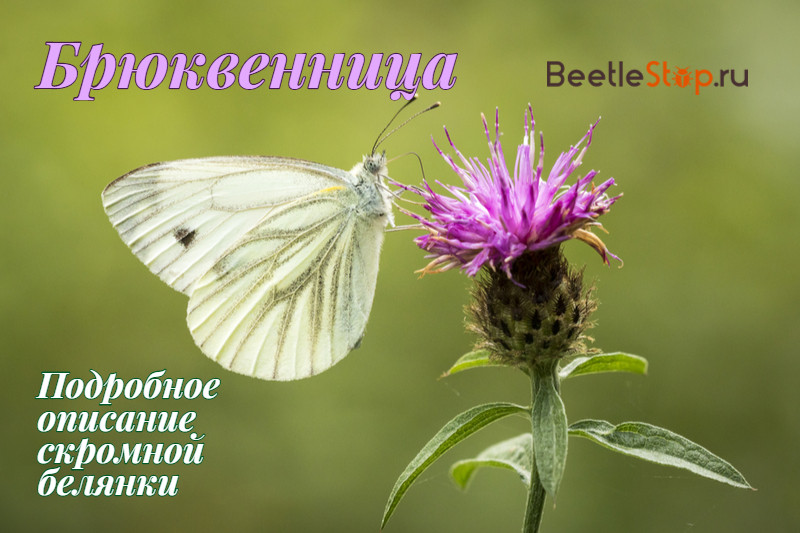Butterfly Squid - summer whitewash
It is easy to meet a white butterfly with dark veins on wings in a garden, on a meadow or on the edge of a forest. One of the most common species of whitewater butterfly butterflies is found throughout Europe, in northern Africa and America. Adult insects feed on flowers, and caterpillars are pests of garden crops - turnips, rutabaga, cabbage, mustard.

View description
Butterfly rutabaga or Pierisnapi was named after the main feed plant rutabaga (napus). An insect from the white family is characterized by an average size, wingspan of 35-40 mm. The main color is white, along the veins black or gray spraying. The base and extreme sections of the front wing are covered with dark scales. On the back of the wings, the pattern is more pronounced. The darkened veins are clearly visible, the hind wing is yellowish or yellowish-green.
Information. It is easy to distinguish the male bruennifer from the female - he has one black spot on the front wing, and two females.
The spring and summer form of Lepidoptera differs in size and color intensity. The summer moths are larger, the second generation of birch bark butterfly shows a lighter pattern on the back of the wings. Males that appeared in the spring often lack black dots on the fore wings.
The moth's head and chest are covered with gray or yellow hairs. The eyes are large, faceted. Antennae light, dark mace at the tips. The long proboscis is used to feed nectar. In the normal state, the organ is twisted into a spiral.
Interesting fact. Male ruthenian women smell like lemon oil.
Subspecies
Butterfly white rutabaga has several subspecies living in different regions:
- P. n. atlantis - Morocco;
- P. n. japonica - Japan;
- P. n. keskuelai - Ural mountains;
- P. n. Mogollon - USA, Arizona and many others.
Distribution area
The species is widespread in Europe, occasionally flies over the Arctic Circle. It lives in the temperate zone of Asia, in the North of Africa. Bukvennitsa is known in China, Japan and Korea. In Russia, it is found in territories from European, central, Siberian regions. The species is common in the Far East, Sakhalin, Kamchatka.
Lifestyle
Butterflies prefer wet areas, settle on the edges of the forest, in fields, on roadsides. Not rare guests of bryukvennitsa in gardens, parks and gardens. Cookwort dishes are found in meadows located in the mountains at an altitude of up to 2000 m. Adults feed on cruciferous and leguminous plants. A moth can be seen on a geranium or dandelion. Depending on the climatic zone of years, insects are observed from April to September, occasionally in October.
Male percussion cattle gather in large groups in moist areas of the soil, where they replenish mineral reserves. They appear earlier than females, therefore, in anticipation of mating, they spend time eating nectar and substances dissolved in water. Insects are active in the daytime, awaiting bad weather in shelter.
Propagation Features
In the central European regions, the Butterfly Butterfly butterfly gives two generations per year. Closer to the north - one, and in the south - three. Representatives of generations differ in the size and brightness of the picture. During courtship, males fly after females, do not show aggression towards rivals.Fertilized butterflies lay one egg on the side of the leaves. The offspring feeds on various plants:
- garlic
- garden cabbage;
- turnip;
- swede;
- core;
- mignonette;
- turnip.
Of the yellow oblong eggs with 14 ribs, a caterpillar appears after 5-6 days. At the first age, it is light green, size 1.8 mm. The body is covered with transparent hairs. The head is large, pale yellow with dark spots of eyes. After birth, the larva eats eggshells. After the first molt, the caterpillar becomes darker, longitudinal rows of light warts appear on the body.
The larva of the bryuvennitsa starts eating the leaf from the middle. Only adults of the last fifth age feed on the edges of the leaf plate. For 11-12 days, the larva grows to 22 mm. Her green body is covered with hairs with black dots at the base. On the sides are dark spiracles with a bright yellow border.
The wintering stage is the pupa. In this case, the development time is delayed by 10 months. In the summer generation, an adult appears from a green chrysalis a week later. A pupa develops near the fodder plant. It is attached with a silk belt to a branch, a stone, a stalk. The first generation of insects flies from May to June, the second, more numerous, appears in July. The last third generation of butterflies is observed until the end of September. In protracted warm weather, active bryuks can be seen in October. In autumn, the insect life cycle ends.

